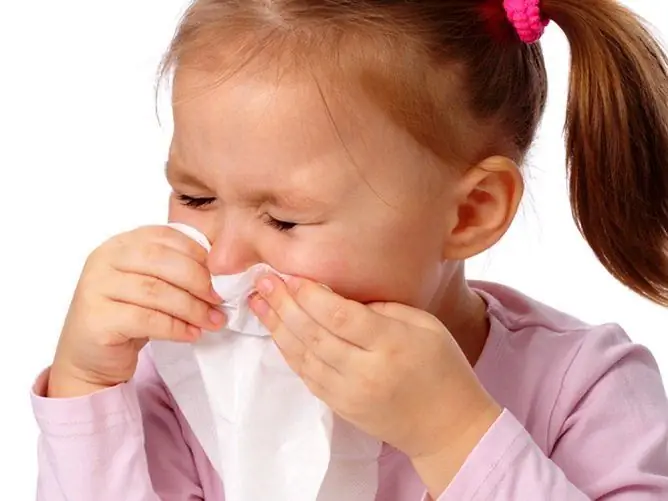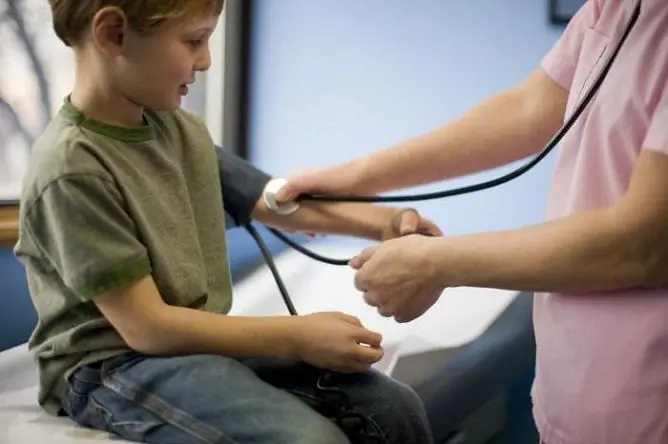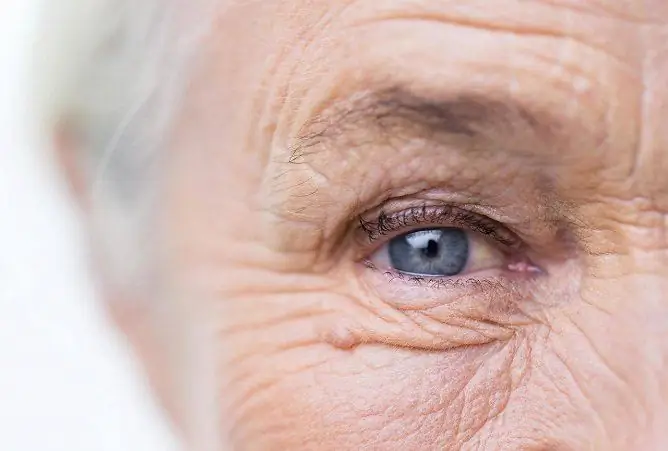- Author Rachel Wainwright [email protected].
- Public 2023-12-15 07:39.
- Last modified 2025-11-02 20:14.
What antibiotic for angina is better for a child to use: a list of drugs, features of therapy
The content of the article:
-
The reasons for the development of pathology
- Trigger factors
- Anatomical features of the development of glands
- Indications for antibiotic therapy
-
Sore throat treatment
-
Effective antibiotics for angina in children: names of drugs, treatment regimen
- Benzylpenicillin
- Flemoxin Solutab
- Hikontsil
- Clarithromycin
- Azithromycin
- Rovamycin
- Amoxicillin
- Phenoxymethylpenicillin
- Hemomycin
- Sumamed
- Local therapy
- Features of caring for a sick child
-
- Video
Antibiotics for angina in children should be used as directed by a pediatric otolaryngologist or pediatrician after a bacteriological study. Self-selection of such funds is not recommended, since treatment may be ineffective, which will lead to the transition of an acute form of tonsillitis to a chronic one, as well as to the spread of the inflammatory process with blood flow to tissues and organs.

Antibiotics for angina children should be prescribed by a pediatrician or an ENT doctor
Self-medication, as well as the late initiation of adequate therapy for the disease, is fraught with the development of complications such as acute glomerulonephritis, rheumatism and other pathologies associated with GABHS antigens (group A β-hemolytic streptococcus) and having an infectious-allergic nature.
The following forms of angina (acute tonsillitis) are distinguished:
- lacunar;
- catarrhal;
- fibrinous;
- follicular;
- phlegmonous (intratonsillar abscess);
- ulcerative necrotic (Simanovsky - Vincent);
- herpetic;
- mixed.
The reasons for the development of pathology
The causes of the development of the disease in children are viruses, bacteria, fungi and spirochetes. In 50-80% of cases, the causative agent of angina is GABHS, less often - streptococci of groups C and G, spirochetes, anaerobes, corynebacteria (Corynebacterium diphtheriae, Arcanobacterium haemolyticum), gonococcus, and in extremely rare cases - chlamydia and mycoplasma. Acute viral tonsillitis can be caused by rhinoviruses, adenoviruses, coronaviruses, Coxsackie virus, Epstein-Barr virus, influenza and parainfluenza.

In most cases, streptococci lead to the development of pathology.
With the viral or fungal nature of angina, antibiotic treatment in children is not carried out. In such cases, antiviral or antifungal agents should be used.
Pathogens enter the body mainly by airborne droplets, but contact and nutritional routes of infection should not be overlooked.

The pathogen can be transmitted both by airborne droplets and by contact
The source of the disease is a person suffering from acute tonsillitis, scarlet fever and other clinical forms of cutaneous and respiratory streptococcal infection. Also, infection can occur upon contact with bacterial carriers of pyogenic streptococcus.
The occurrence of an endogenous infection is directly related to the presence of chronic tonsillitis in a child. Frequent sore throats against the background of this disease are due to the fact that in 75% of cases, patients are carriers of GABHS, vegetating in the crypts of the tonsils.
Trigger factors
The factors that predispose to the development of pathology include:
- decrease in the general reactivity of the body to cold;
- sharp fluctuations in environmental conditions - humidity, temperature;
- irregular or inadequate nutrition, lack of intake of vitamins from food;
- trauma to the glands;
- constitutional predisposition to acute tonsillitis: in children with a lymphatic-hyperplastic constitution, the likelihood of developing pathology is increased;
- disorders of the central and autonomic nervous system;
- chronic inflammatory processes in the paranasal sinuses, mouth and nose.
Anatomical features of the development of glands
Anatomical and functional features of the development of glands play a significant role in the appearance of inflammation in children. So, in infants, the tonsils are underdeveloped and functionally inactive, therefore they cannot become inflamed. By the end of 1 year, the final formation of follicles occurs, and closer to 2 years, the tonsils also reach their full development.
Up to 5 years, there is a replacement of the multilayered columnar ciliated epithelium, which covers the tonsils, with squamous epithelium. Then comes the turn of follicular hyperplasia, and the completion of the growth of the tonsils occurs closer to 7 years.
The period from 5 to 7 years is characterized by the highest infectious morbidity. In children after 9 years, and sometimes after 8 years, age-related involution of lymphoid tissue begins, and acute tonsillitis does not occur so often.
Indications for antibiotic therapy
In clinical practice, all sore throats are divided into two groups - banal (vulgar) and atypical. The former have four common features:
- bacterial or viral nature of the infection;
- pathological changes in both palatine tonsils;
- severe general intoxication of the body;
- the duration of the disease does not exceed 7 days.
In what cases do children need to drink antibiotics with angina? It is banal sore throats of bacterial genesis that must be treated with antibiotics. They are diagnosed in most patients, and among them the most common are lacunar, follicular and catarrhal forms. The symptoms of these types of acute tonsillitis are:
- catarrhal: perspiration, dryness, burning and a slight pain in the throat (when swallowing), headache, general malaise, low-grade body temperature (37.1-38.0 ° C), diffuse hyperemia and swelling of the glands and edges of the palatine arches, slight increase regional lymph nodes, dry tongue. In children, these manifestations are more pronounced than in adults;
- follicular: damage to the parenchyma of the tonsils, chills, fever up to 39-40 ° C, severe sore throat, severe intoxication, oliguria or dyspeptic symptoms, swelling and hyperemia of the palatine tonsils, the presence of whitish-yellow follicles on the surface of the tonsils, pronounced regional lymphadenitis;
- lacunar: the onset of pathology, as well as its general signs, are similar to the follicular form, but the course is more severe. When carrying out pharyngoscopy, hyperemia and an increase in the size of the tonsils, the presence of islets of yellowish-white plaque are found.
Sore throat treatment
With angina, local and general therapy is indicated, as well as the child's adherence to a sparing regimen.

For moderate or severe bacterial sore throat, antibiotics are the first line
Antibacterial agents are first line drugs. Without their use, acute tonsillitis of bacterial origin cannot be quickly cured. Moreover, therapy without the use of such drugs increases the risk of complications. Prior to their appointment, a test should be carried out to confirm the presence of bacterial agents. However, there are cases when the use of such tools can be started without analysis, namely:
- moderate or severe pathology;
- test results will be received only after 72 hours or more;
- further medical observation of the patient will be difficult.
Antibiotics can be given to a child only as directed by a doctor and in accordance with the prescribed regimen. It is not recommended to choose such drugs on your own, since only ENT can determine the daily dose in accordance with the child's age and body weight and determine how many days to take the medicine.
Well-chosen antibiotic therapy should follow goals such as:
- elimination of bacteria;
- shortening the period of contagiousness to eliminate the risk of transmission of infection to people around them through close contact;
- prevention of potential complications;
- quick relief of manifestations of pathology and acceleration of the healing process.

For children under 4 years of age, antibiotics are most often given in suspension
In children under the age of 4 years of age, it is preferable to use antibacterial drugs in the form of granules or powder, from which a suspension is prepared, which is associated with the complexity of the dosage and the possible difficulty in swallowing capsules or tablets.
It should be borne in mind that early withdrawal of antibiotics increases the risk of consequences. It is important to bring the course prescribed by the doctor to the end, even if there is an improvement in the patient's condition after the first days of taking the drug.
Effective antibiotics for angina in children: names of drugs, treatment regimen
Benzylpenicillin
The drug is available in the form of a powder for the preparation of a solution for intramuscular or subcutaneous administration. Refers to the old (first) penicillin antibiotics.

Benzylpenicillin is an antibiotic of the group of biosynthetic penicillins that have a bactericidal effect
The route of administration for acute tonsillitis is intramuscular. Immediately before use, the powder is dissolved in water for injection, 0.9% sodium chloride solution or 0.5% procaine solution. The drug can be used in children of all age groups, including up to 1 year.
The duration of therapy varies from 7 to 10 days, depending on the form and severity of angina.
Flemoxin Solutab
It is a broad-spectrum acid-fast antibiotic from the group of semi-synthetic penicillins in the form of dispersible tablets. The dose of the drug and the frequency of its administration are set individually, depending on the patient's age.
In case of mild and moderate course of pathology, the duration of the course is 5-7 days, and if the causative agent is pyogenic streptococcus - at least 10 days. It is recommended to continue taking pills for 48 hours after the symptoms of the disease disappear.

Flemoxin Solutab is one of the most frequently prescribed antibiotics for acute tonsillitis
Hikontsil
It is a broad-spectrum penicillin antibiotic, produced in powder form for preparation of a suspension for oral administration. Immediately before use, it is diluted in boiled water at room temperature. The finished suspension is taken before or after meals. The dose for children is set depending on the body weight.
Clarithromycin
Clarithromycin is a macrolide in the form of film-coated tablets. It is used in children over the age of 12.
The course of therapy for angina is 10 days.

Clarithromycin belongs to the macrolide group and is prescribed for children over 12 years old
Azithromycin
The drug belongs to the macrolide group. In acute tonsillitis, it is used in film-coated tablets. At a dosage of 125 mg, it is contraindicated in children under 3 years of age, 250 and 500 mg - under 12 years of age, including 11 years. The tablets are taken orally 1 hour before or two hours after a meal.
Rovamycin
The drug is from the macrolide group, produced in the form of film-coated tablets. It is used in children over 6 years of age.
Amoxicillin
It is a semi-synthetic penicillin in granules for the preparation of a suspension for oral administration. Can be used in children of all age groups, including newborns.

Amoxicillin can be used in children of all ages, including newborns
The dose of the drug and the frequency of its administration depend on the age of the patient. So, for example, in children aged 3 months to 10 years, it is recommended to take granules 3 times a day, up to 3 months - 2 times a day.
To prepare a suspension, water is added to the granules. In finished form, the product can be stored in the refrigerator for 2 weeks. The duration of therapy varies from 5 to 12 days.
Phenoxymethylpenicillin
This is a biosynthetic penicillin, for acute tonsillitis it is used in the form of a powder for the preparation of a suspension for oral administration and tablets. The powder is prescribed for children aged 3 months, tablets - over 3 years old.
Children aged 5 years and older should take the prepared suspension every 6-8 hours, up to 5 years - every 6 hours. The duration of treatment is on average 7-10 days.
Hemomycin
Macrolide antibiotic, azalide. In children with acute tonsillitis, it is used in the form of a powder for the preparation of a suspension taken orally. The drug is not used in patients under the age of 1 year.
To prepare a suspension, distilled or boiled chilled water is added to the powder. The dose is set depending on the weight of the child.

Hemomycin in the form of a suspension is prescribed for children from 1 year old
Sumamed
It belongs to the number of azalides with a wide spectrum of antimicrobial action, it is available in three dosage forms - coated tablets, capsules, powder for preparation of a suspension for oral administration.
In children aged 6 months, tablets and a suspension prepared from a powder can be used.

The drug Sumamed has a wide spectrum of action and is effective in the treatment of angina
Local therapy
Local treatment is recommended along with antibiotics for acute tonsillitis. Gargling with Furacilin, Miramistin, decoctions of chamomile and sage, salt and soda solutions can be carried out. The temperature of the liquids used should be in the range from 40 to 50 ° С, the procedures should be carried out 4-6 times a day. Regular gargling is good for relieving sore throat and making it easier to swallow food or water.

In addition to antibiotic therapy, local treatment is carried out
To reduce the severity of acute sore throat, lozenges or lozenges can also be used, the oral cavity is irrigated with sprays or aerosols with anti-inflammatory and antimicrobial effects, namely:
- Strepsils: an antiseptic preparation in lozenges, intended for use in patients aged 6 years and older. For children with hereditary fructose intolerance and glucose-galactose or sucrose-isomaltose malabsorption syndrome, its appointment is contraindicated;
- Lizobact: combined antiseptic agent in tablets for resorption. Contraindicated in children under 3 years of age, as well as in the presence of lactase deficiency, lactose intolerance or glucose-galactose malabsorption. When taken in combination with antibacterial drugs, Lizobact enhances their effect;
- Grammidin for children: a combined drug with antiseptic and antimicrobial properties. Available in two forms - metered spray for topical application and lozenge tablets. After a meal, the spray is sprayed onto the mucous membrane of the throat and oral cavity, it is prescribed for children over 6 years old. The tablets can be used in patients over the age of 4;
- Ingalipt: Antimicrobial spray or aerosol used in children over 3 years of age. Throat irrigation is carried out after preliminary rinsing of the oral cavity with boiled water 3-4 times a day.
These medications should not be used as alternatives to primary treatment, but should only be used as an adjunct to antibiotics. In the acute period, when the temperature rises to 38 ° C and with severe pain, antipyretic and analgesic drugs can be used on the recommendation of a doctor.
In severe acute tonsillitis, treatment should be carried out in an infectious hospital. Antibacterial drugs in such cases are administered parenterally.
The indicators of the relief of the manifestations of angina in children are the absence of sore throat, normalization of body temperature, the size of the tonsils and the maxillary lymph nodes. Also, the results of the analysis of blood and urine, the indicators of which are within the normal range, indicate recovery.
Features of caring for a sick child
On the first day of the acute period of pathology, before the normalization of body temperature, bed rest is recommended. Dr. Komarovsky emphasizes that one should not limit any activity of children during this period and force them to lie motionless in bed. The main thing is to focus on the desire of the child himself and his general condition.

During the acute course of angina in the absence of appetite, it is not recommended to force the child to eat
It is recommended to follow the same approach with regard to food - it should be taken only if there is an appetite. Preference should be given to vegetable and dairy foods, as well as soft, warm and mild dishes - broths and purees. An abundant warm drink is of great importance - tea, dried fruit compote, mineral water.
Video
We offer for viewing a video on the topic of the article.

Anna Kozlova Medical journalist About the author
Education: Rostov State Medical University, specialty "General Medicine".
Found a mistake in the text? Select it and press Ctrl + Enter.






